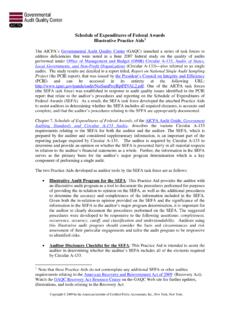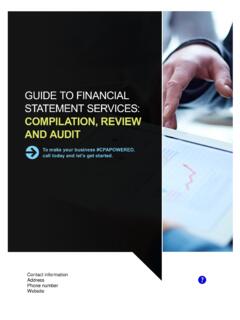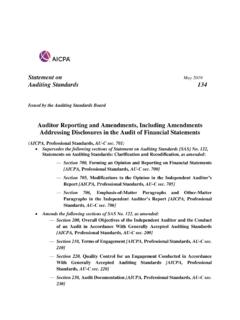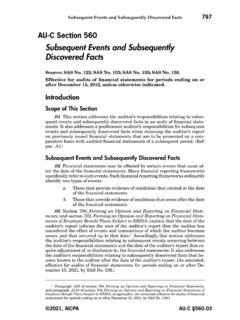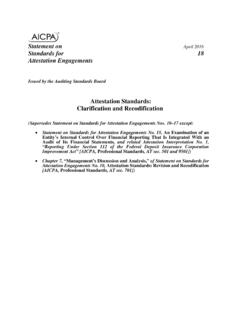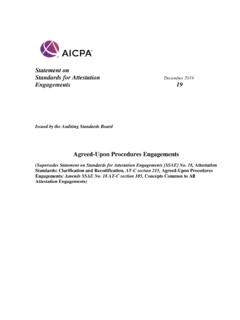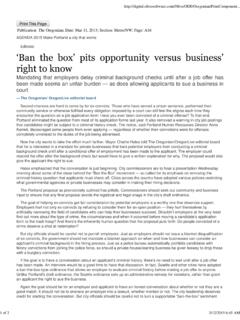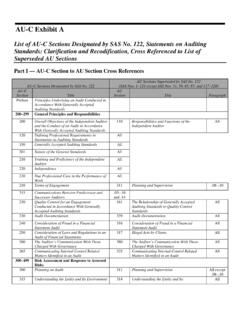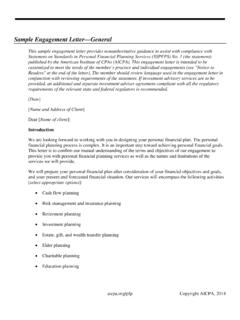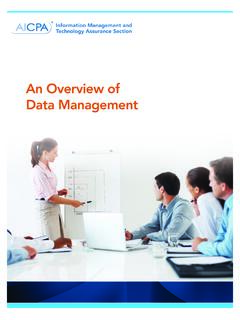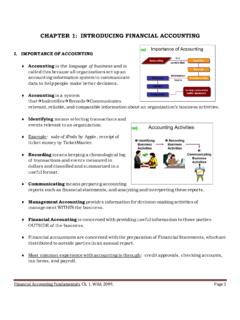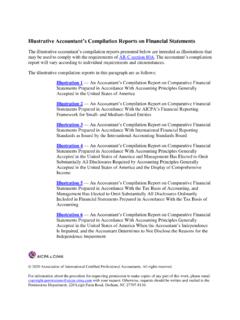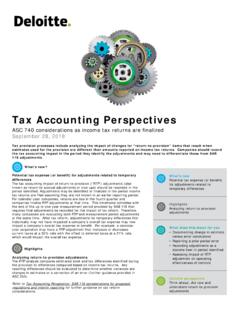Transcription of Management Representations - American Institute of ...
1 Management Representations1941AU Section 333 Management Representations (Supersedes SAS No. 19.)Source: SAS No. 85; SAS No. 89; SAS No. 99; SAS No. section 9333 for interpretations of this for audits of financial statements for periods ending on orafter June 30, 1998, unless otherwise section establishes a requirement that the independent auditorobtain written Representations from Management as a part of an audit of fi-nancial statements performed in accordance with generally accepted auditingstandards and provides guidance concerning the Representations to be on Management an audit, Management makes many Representations to the au-ditor, both oral and written, in response to specific inquiries or through the fi-nancial statements. Such Representations from Management are part of theaudit evidence the independent auditor obtains, but they are not a substitutefor the application of those auditing procedures necessary to afford a reasonablebasis for an opinion regarding the financial statements under audit.
2 Writtenrepresentations from Management ordinarily confirm Representations explic-itly or implicitly given to the auditor, indicate and document the continuingappropriateness of such Representations , and reduce the possibility of misun-derstanding concerning the matters that are the subject of the Representations .[Revised, March 2006, to reflect conforming changes necessary due to the is-suance of Statement on Auditing Standards No. 105.] auditor obtains written Representations from Management to com-plement other auditing procedures. In many cases, the auditor applies audit-ing procedures specifically designed to obtain audit evidence concerning mat-ters that also are the subject of written Representations . For example, afterthe auditor performs the procedures prescribed in section 334,Related Par-ties, even if the results of those procedures indicate that transactions with re-lated parties have been properly disclosed, the auditor should obtain a writtenrepresentation to document that Management has no knowledge of any suchtransactions that have not been properly disclosed.
3 In some circumstances, au-dit evidence that can be obtained by the application of auditing proceduresother than inquiry is limited; therefore, the auditor obtains written represen-tations to provide additional audit evidence. For example, if an entity plans todiscontinue a line of business and the auditor is not able to obtain sufficient in-formation through other auditing procedures to corroborate the plan or intent,1 Section 230,Due Professional Care in the Performance of Work, states, "The auditor neitherassumes that Management is dishonest nor assumes unquestioned honesty. In exercising professionalskepticism, the auditor should not be satisfied with less than persuasive evidence because of a beliefthat Management is honest."AU Standards of Field Workthe auditor obtains a written representation to provide evidence of manage-ment's intent.
4 [Revised, March 2006, to reflect conforming changes necessarydue to the issuance of Statement on Auditing Standards No. 105.].04If a representation made by Management is contradicted by other auditevidence, the auditor should investigate the circumstances and consider thereliability of the representation made. Based on the circumstances, the auditorshould consider whether his or her reliance on Management 's representationsrelating to other aspects of the financial statements is appropriate and Written Representations from Management should be obtained for allfinancial statements and periods covered by the auditor's example,if comparative financial statements are reported on, the written representa-tions obtained at the completion of the most recent audit should address allperiods being reported on. The specific written Representations obtained by theauditor will depend on the circumstances of the engagement and the natureand basis of presentation of the financial connection with an audit of financial statements presented in accor-dance with generally accepted accounting principles , specific representationsshould relate to the following matters.
5 3 Financial 's acknowledgment of its responsibility for the fair pre-sentation in the financial statements of financial position, results ofoperations, and cash flows in conformity with generally accepted ac-counting 's belief that the financial statements are fairly presentedin conformity with generally accepted accounting of of all financial records and related and availability of all minutes of meetings of stockhold-ers, directors, and committees of from regulatory agencies concerning noncompliancewith or deficiencies in financial reporting of unrecorded , Measurement, and 's belief that the effects of any uncorrected financial state-ment misstatements4aggregated by the auditor during the currentengagement and pertaining to the latest period presented are immate-rial, both individually and in the aggregate, to the financial statements2An illustrative representation letter from Management is contained in paragraph.
6 16 of ap-pendix A, "Illustrative Management representation Letter".3 Specific Representations also are applicable to financial statements presented in conformity witha comprehensive basis of accounting other than generally accepted accounting principles . The specificrepresentations to be obtained should be based on the nature and basis of presentation of the financialstatements being .07 of section 312,Audit Risk and Materiality in Conducting an Audit, states thata misstatement can result from errors or fraud, and provides guidance for the auditor's evaluationof audit findings (paragraphs of section 312). [Footnote added, effective for audits of financialstatements for periods beginning on or after December 15, 1999, by Statement on Auditing StandardsNo. 89.]AU Representations1943taken as a (A summary of such items should be included in orattached to the letter.)
7 6, 's acknowledgment of its responsibility for the design andimplementation of programs and controls to prevent and detect of fraud or suspected fraud affecting the entity involving(1) Management , (2) employees who have significant roles in internalcontrol, or (3) others where the fraud could have a material effect onthe financial statements.[8] of any allegations of fraud or suspected fraud affecting theentity received in communications from employees, former employees,analysts, regulators, short sellers, or or intentions that may affect the carrying value or classificationof assets or concerning related-party transactions and amounts re-ceivable from or payable to related , whether written or oral, under which the entity is contin-gently estimates and material concentrations known to manage-ment that are required to be disclosed in accordance with FinancialAccounting Standards Board (FASB) accounting Standards Codifica-tion(ASC)
8 275,Risks and or possible violations of laws or regulations whose effectsshould be considered for disclosure in the financial statements or as abasis for recording a loss claims or assessments that the entity's lawyer has advisedare probable of assertion and must be disclosed in accordance withFASB ASC 450, Management believes that certain of the identified items are not misstatements, manage-ment's belief may be acknowledged by adding to the representation , for example, "We do not agreethat items XX and XX constitute misstatements because [description of reasons]." [Footnote added,effective for audits of financial statements for periods beginning on or after December 15, 1999, byStatement on Auditing Standards No. 89.]6 Paragraph .42 of section 312 states that the auditor may designate an amount below which mis-statements need not be accumulated.
9 Similarly, the summary of uncorrected misstatements includedin or attached to the representation letter need not include such misstatements. The summary shouldinclude sufficient information to provide Management with an understanding of the nature, amount,and effect of the uncorrected misstatements. Similar items may be aggregated. [Footnote added, ef-fective for audits of financial statements for periods beginning on or after December 15, 1999, byStatement on Auditing Standards No. 89.]7 The communication to Management of immaterial misstatements aggregated by the auditordoes not constitute a communication pursuant to paragraph .17 of section 317,Illegal Acts by Clients,Section 10A of the Securities Exchange Act of 1934, or paragraphs .38 .40 of section 316,Consid-eration of Fraud in a Financial Statement Audit. The auditor may have additional communicationresponsibilities pursuant to section 317, Section 10A of the Securities Exchange Act of 1934, or section316.
10 [Footnote added, effective for audits of financial statements for periods beginning on or after De-cember 15, 1999, by Statement on Auditing Standards No. 89. Footnote renumbered by the issuanceof Statement on Auditing Standards No. 89, December 1999.][8][Footnote deleted by the issuance of Statement on Auditing Standards No. 99, October 2002.]9 See section 334. [Footnote renumbered by the issuance of Statement on Auditing Standards , December 1999.]10 See section 317. [Footnote renumbered by the issuance of Statement on Auditing StandardsNo. 89, December 1999.]11 See paragraph .05 of section 337,Inquiry of a Client's Lawyer Concerning Litigation,Claims, and Assessments. If the entity has not consulted a lawyer regarding litigation, claims, and(continued)AU Standards of Field liabilities and gain or loss contingencies that are required to beaccrued or disclosed by FASB ASC title to assets, liens or encumbrances on assets, and assetspledged as with aspects of contractual agreements that may affectthe financial concerning subsequent [As amended, effective for audits of financial statements for periods beginningon or after December 15, 1999, by Statement on Auditing Standards No.]
